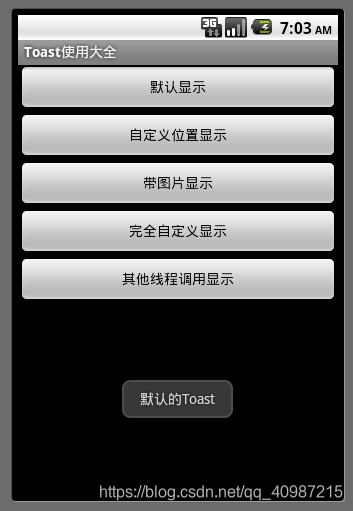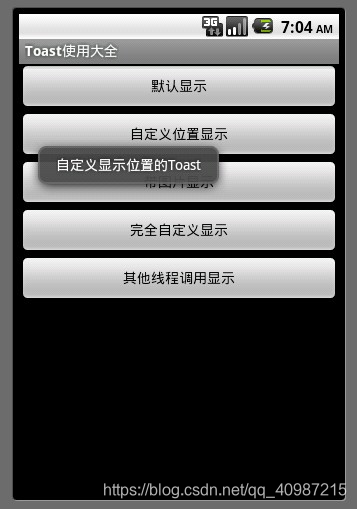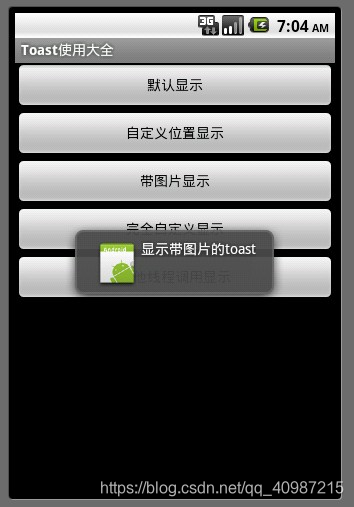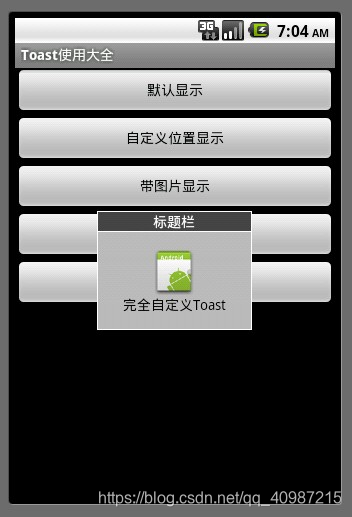android 的用户界面一般使用xml文件做的,对应的xml文件在layout包下
如果xml里放了个按钮什么的,在activity中要获取该按钮就用
findViewById(R.id.xml文件中对应的id)
它可以使用用户滚动显示一个占据的空间大于物理显示的视图列表。值得注意的是,ScrollView只能包含一个子视图或视图组,在实际项目中,通常包含的是一个垂直的LinearLayout。
值得注意的是,ScrollView不能和ListView一起使用,因为ListView已经对垂直方向的滚动做了处理,它会迫使如果ListView的内容大于物理视图的内容的时候,强制垂直滚动的效果,所以这里使用ScrollView和ListView混合使用是没有意义的
在Android平台下,与ScrollView类似的还有一个HorizontalScrollView容器,这个容器与ScrollView的作用相反,主要适用于水平滚动,了解了ScrollView就基本上了解了HorizontalScrollView
<?xml version="1.0" encoding="utf-8"?>
2 <ScrollView xmlns:android="http://schemas.android.com/apk/res/android"
3 android:layout_width="match_parent"
4 android:layout_height="match_parent" >
5
6 <LinearLayout
7 android:layout_width="match_parent"
8 android:layout_height="wrap_content"
9 android:orientation="vertical" >
10
11 <TextView
12 android:layout_width="match_parent"
13 android:layout_height="wrap_content"
14 android:text="垂直滚动视图"
15 android:textSize="30dp" />
16
17 <ImageView
18 android:layout_width="match_parent"
19 android:layout_height="wrap_content"
20 android:src="@drawable/bmp1" />
21
22 <ImageView
23 android:layout_width="match_parent"
24 android:layout_height="wrap_content"
25 android:src="@drawable/bmp2" />
26
27 <ImageView
28 android:layout_width="match_parent"
29 android:layout_height="wrap_content"
30 android:src="@drawable/bmp3" />
31
32 <EditText
33 android:maxLines="2"
34 android:layout_width="match_parent"
35 android:layout_height="40dp" />
36
37 <ImageView
38 android:layout_width="match_parent"
39 android:layout_height="wrap_content"
40 android:src="@drawable/bmp4" />
41
42 <ImageView
43 android:layout_width="match_parent"
44 android:layout_height="wrap_content"
45 android:src="@drawable/bmp5" />
46
47 <ImageView
48 android:layout_width="match_parent"
49 android:layout_height="wrap_content"
50 android:src="@drawable/bmp6" />
51
52 <ImageView
53 android:layout_width="match_parent"
54 android:layout_height="wrap_content"
55 android:src="@drawable/bmp7" />
56
57 <ImageView
58 android:layout_width="match_parent"
59 android:layout_height="wrap_content"
60 android:src="@drawable/bmp8" />
61
62 <ImageView
63 android:layout_width="match_parent"
64 android:layout_height="wrap_content"
65 android:src="@drawable/bmp9" />
66
67 <ImageView
68 android:layout_width="match_parent"
69 android:layout_height="wrap_content"
70 android:src="@drawable/bmp10" />
71 </LinearLayout>
72
73 </ScrollView>说明: 获得已安装的应用程序信息 。可以通过getPackageManager()方法获得。
public abstract PackageManager getPackageManager() 功能:获得一个PackageManger对象
public abstract Drawable getApplicationIcon(String packageName) 参数: packageName 包名 功能:返回给定包名的图标,否则返回null
public abstract ApplicationInfo getApplicationInfo(String packageName, int flags) 参数:
packagename 包名 flags 该ApplicationInfo是此flags标记,通常可以直接赋予常数0即可 功能:返回该ApplicationInfo对象
public abstract List<ApplicationInfo> getInstalledApplications(int flags) 参数:
flag为一般为GET_UNINSTALLED_PACKAGES,那么此时会返回所有ApplicationInfo。我们可以对ApplicationInfo 的flags过滤,得到我们需要的。 功能:返回给定条件的所有PackageInfo
public abstract List<PackageInfo> getInstalledPackages(int flags) 参数如上 功能:返回给定条件的所有PackageInfo
public abstractResolveInfo resolveActivity(Intent intent, int flags) 参数:
intent 查寻条件,Activity所配置的action和category flags: MATCH_DEFAULT_ONLY :Category必须带有CATEGORY_DEFAULT的Activity,才匹配 GET_INTENT_FILTERS :匹配Intent条件即可 GET_RESOLVED_FILTER :匹配Intent条件即可 功能 :返回给定条件的ResolveInfo对象(本质上是Activity)
public abstract List<ResolveInfo> queryIntentActivities(Intent intent, int flags) 参数同上 功能 :返回给定条件的所有ResolveInfo对象(本质上是Activity),集合对象
public abstract ResolveInfo resolveService(Intent intent, int flags) 参数同上 功能 :返回给定条件的ResolveInfo对象(本质上是Service)
public abstract List<ResolveInfo> queryIntentServices(Intent intent, int flags) 参数同上 功能 :返回给定条件的所有ResolveInfo对象(本质上是Service),集合对象
getPackageManager().hasSystemFeature(String string).通过该函数判断系统是否有特定的模块功能。
getPackageManager().hasSystemFeature(PackageManager.FEATURE_WIFI);
getPackageManager().hasSystemFe(PackageManager.FEATURE_BLUETOOTH);
Toast 是一个 View 视图,快速的为用户显示少量的信息。 Toast 在应用程序上浮动显示信息给用户,它永远不会获得焦点,不影响用户的输入等操作,主要用于 一些帮助 / 提示。
Toast 最常见的创建方式是使用静态方法 Toast.makeText
----------------------------------------------------------------------------------------------------------------------------------------------------------------------------------------------------------------------------------------------------
// 第一个参数:当前的上下文环境。可用getApplicationContext()或this
// 第二个参数:要显示的字符串。也可是R.string中字符串ID
// 第三个参数:显示的时间长短。Toast默认的有两个LENGTH_LONG(长)和LENGTH_SHORT(短),也可以使用毫秒如2000ms
Toast toast=Toast.makeText(getApplicationContext(), "默认的Toast", Toast.LENGTH_SHORT);
---------------------------------------------------------------------------------------------------------------------------------------------------------------------------------------------
1 Toast toast=Toast.makeText(getApplicationContext(), "自定义显示位置的Toast", Toast.LENGTH_SHORT);
2 //第一个参数:设置toast在屏幕中显示的位置。我现在的设置是居中靠顶
3 //第二个参数:相对于第一个参数设置toast位置的横向X轴的偏移量,正数向右偏移,负数向左偏移
4 //第三个参数:同的第二个参数道理一样
5 //如果你设置的偏移量超过了屏幕的范围,toast将在屏幕内靠近超出的那个边界显示
6 toast.setGravity(Gravity.TOP|Gravity.CENTER, -50, 100);
7 //屏幕居中显示,X轴和Y轴偏移量都是0
8 //toast.setGravity(Gravity.CENTER, 0, 0);
9 toast.show();
-------------------------------------------------------------------------------------------------------------------------------------------------------------------------------
1 Toast toast=Toast.makeText(getApplicationContext(), "显示带图片的toast", 3000);
2 toast.setGravity(Gravity.CENTER, 0, 0);
3 //创建图片视图对象
4 ImageView imageView= new ImageView(getApplicationContext()); 5 //设置图片
6 imageView.setImageResource(R.drawable.ic_launcher);
7 //获得toast的布局
8 LinearLayout toastView = (LinearLayout) toast.getView();
9 //设置此布局为横向的
10 toastView.setOrientation(LinearLayout.HORIZONTAL);
11 //将ImageView在加入到此布局中的第一个位置
12 toastView.addView(imageView, 0);
13 toast.show();
---------------------------------------------------------------------------------------------------------------------------------------------------------------------------------------------------------------------------------------
-----------------------------------------------------------------------------
2 //LayoutInflater这个类用来实例化XML文件到其相应的视图对象的布局
3 LayoutInflater inflater = getLayoutInflater();
4 //通过制定XML文件及布局ID来填充一个视图对象
5 View layout = inflater.inflate(R.layout.custom2,(ViewGroup)findViewById(R.id.llToast));
6
7 ImageView image = (ImageView) layout.findViewById(R.id.tvImageToast);
8 //设置布局中图片视图中图片
9 image.setImageResource(R.drawable.ic_launcher);
10
11 TextView title = (TextView) layout.findViewById(R.id.tvTitleToast);
12 //设置标题
13 title.setText("标题栏");
14
15 TextView text = (TextView) layout.findViewById(R.id.tvTextToast);
16 //设置内容
17 text.setText("完全自定义Toast");
18
19 Toast toast= new Toast(getApplicationContext());
20 toast.setGravity(Gravity.CENTER , 0, 0);
21 toast.setDuration(Toast.LENGTH_LONG);
22 toast.setView(layout);
23 toast.show();
 Android UI与应用管理
Android UI与应用管理





























 被折叠的 条评论
为什么被折叠?
被折叠的 条评论
为什么被折叠?








